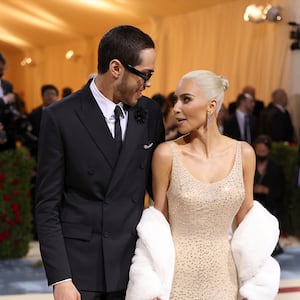On Monday, Kim Kardashian wore Marilyn Monroe’s iconic “Happy Birthday, Mr. President” dress, Emily Ratajkowski wore not very much, and there was a confusion about how many Jared Letos there were. In other words, the “Gilded Glamour”-themed Met Gala was its usual carnival of the amazing and bonkers—which makes it all the stranger that the exhibit that it is supposed to launch in grand style is so pallid.
First, let’s forget the tired, frustrating conversation about whether clothing is art, or belongs in museums: It’s a stupid question, easily answered (yes) and the discourse is long past its expiration date. However, this reporter would argue that to draw audiences and carve out a spot in ancient institutions, fashion exhibitions truly flourish when they’re bombastic.
Take Art of the In-Between, the Metropolitan Museum of Art Costume Institute’s 2017 tribute to visionary Comme des Garçons designer Rei Kawakubo. Kawakubo’s bulbous, squishily sexual, avant-garde creations were just begging for stark galleries and snow white pedestals, and her creations were done justice.
ADVERTISEMENT
In contrast, In America: An Anthology of Fashion (to Sept. 5), the companion piece to 2021’s In America: A Lexicon of Fashion, feels decidedly less grand, despite the sporting contributions from some of the most well-regarded film directors working in the United States today. A little context: 2021’s “Lexicon” explored a plethora of American fashions from the 1940s to the present via categorizing garments within 12 thematic sections: Nostalgia, Belonging, Delight, Joy, Wonder, Affinity, Confidence, Strength, Desire, Assurance, Comfort, and Consciousness. Sure!
“Lexicon” was preoccupied with familiar names like Willy Chavarria, Ralph Lauren, and Tommy Hilfiger. For “Anthology,” the Costume Institute recruited luminaries such as Martin Scorsese, Chloé Zhao, and Sofia Coppola to construct moody dioramas for the fashions on display: garments created by designers and garment workers from the 19th to the mid-late 20th century in America. This amounts to fewer big names in design, but arguably more influential styles.
As you can imagine, these are ambitious projects in scale and scope that you’d think would occupy vast, wide-open museum spaces. We’re trying to get a hold on what American fashion is, after all; this is a huge project. But the museum’s framing choices don’t match up with their goals.
First of all, “Anthology,” is situated in the American Wing of the Met on Fifth Avenue. The American Wing’s period rooms are where the exhibition has been staged, which establishes, off the bat, that environments of cramped domesticity will be the ones that the clothes will occupy. At the entrance, a helpful museum attendant proffered a map of the exhibition layout, indicating that preview audiences had already been getting lost.
Radha Blank’s presentation of We Good. Thx!, her “tribute to the Conjure Woman, who in this very moment are weaving protective cloaks for Black survival in America,” is an early highlight: a long braided headdress with those words emblazoned on it skims down the flounce of a stuffy petticoat.

Chloe Zhao's installation.
Helen HolmesLater, Chloé Zhao’s stunning tribute to American sportswear inventor Claire McCardell—a pitch-perfect, almost Puritanical scene of mannequins clad in the arresting precursors to things like tennis separates, polo shirts and brisk athletic dresses—manages to stop you in your tracks with its lighting and staging. I find Zhao’s films to be far less subversive than they’re touted to be, but she really knocked it out of the park here.
Otherwise, Sofia Coppola’s ill-lit tribute to Custom of the Country-era attire seemed decidedly beneath her. But Martin Scorsese came through at the one-yard line with a stunning presentation in a Frank Lloyd Wright living room. “The extraordinary dresses of Charles James,” the director wrote. “These were my givens, my riches. I needed to find an emotional situation that suggested a story, many stories and that could be felt across the length of that room, in the stances of the men and the women, in what or whom they’re gazing at.”
Good old Marty. It’s a frame from an arresting scene: one female mannequin slumps prettily in an armchair as a strange man gazes at her through a very Wright window, looking like he very much just hurt her feelings. Everyone’s beautifully dressed.
Last year, the Costume Institute’s curator defined American fashion in three words: “heterogeneity, diversity, and pluralism.” That sounds lovely, but had this reporter been holding the curatorial keys, the Met’s biggest wing would’ve been packed with blue jeans and Juicy Couture sweatsuits alongside late 19th century petticoats.
Americans love luxury and utility in equal measure: that’s what makes us so weird. Above all, In America: An Anthology of Fashion, is fundamentally too modest and too reserved. The history of American fashion embraces the tacky as well as the classy; this exhibit is missing, and needs, at least a passing nod to the former.






